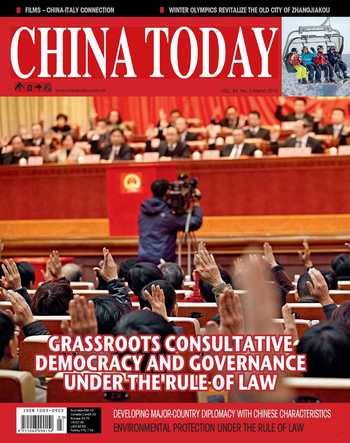Who Has the Upper Hand,China or the U.S.?
By XIANG ANBO
THE U.S. is spearheading economic recovery of the developed world, while China is at the fore of the emerging economies. Throughout this unbalanced, slower than expected resuscitation, China and the U.S. thus remain the two leading engines of global economic growth – a phenomenon that has given rise to debates on which economy is more successful. Quarterly data over the past five years show strong performances by both. China has maintained brisk growth and at the same time improved its economic growth quality; the U.S., meanwhile, has achieved a robust recovery and fostered new growth points.
Comparative Advantages
The U.S. and China consolidated last year their respective status as the worlds largest and second largest economies. Statistics over the past five years show that the China-U.S. quarterly GDP ratio edged up steadily from 37.5 percent in the first quarter of 2010 to 57.8 percent in the third quarter of 2014. Moreover, Chinas quarterly GDP has been increasing at an average rate 4.24 times that of the U.S. But it must be remembered that Chinas yearly GDP growth has fallen from a 12 percent peak to around 7.5 percent, towards what is now known as the“new normal.” U.S. growth, however, remains stable at about 2.3 percent. This lowers the China-U.S. ratio of quarterly GDP growth from 7.57 in the first quarter of 2010 to 3.11 in the third quarter of 2014.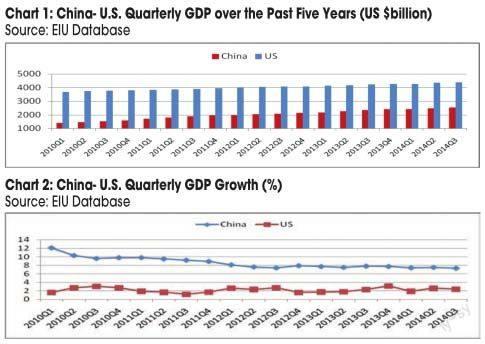
U.S. imports and exports show no marked change, insofar as the country still has a trade deficit. But this has diminished due to such factors as falling oil prices. China has experienced more fluctuations, particularly in seasonal export volumes, but has nevertheless maintained a surplus, having set a record high in 2014.
China stands comparatively high on the Industrial Production Index, and shows greater volatility. The U.S. remains stable at around 100.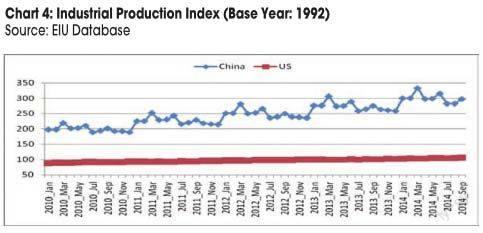
Chinas foreign direct investment (FDI) lags far behind that of the U.S. Despite strong FDI growth over recent years, Chinas FDI is still less than one percent of that of the U.S. If FDI can be taken as a yardstick of a countrys global influence, Chinas international clout would appear to have undergone a rapid surge. But it still has massive catching up to do if it is to match the U.S. in this respect.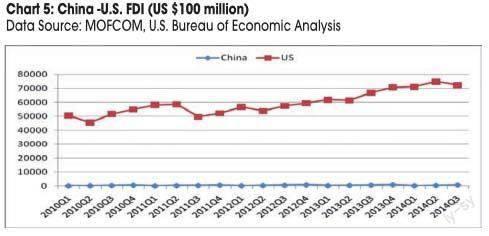
The recovery of the U.S. economy has reduced unemployment from 9.8 percent in the first quarter of 2010 to 4.1 percent in the third quarter of 2014. In China the rate has stayed more or less at four percent.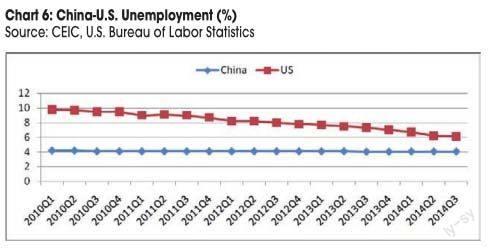
China performs better on the stock market than the U.S. In 2014, the SP500 gained an average 14.69 percent, Nasdaq an average 14.31 percent, and Dow Jones Industry an average 8.403 percent. By contrast, the Shanghai Composite Index soared 40.01 percent and the Shenzhen Composite Index grew 40.68 percent.
All in all, China and the U.S. are in good shape in comparison with other economies. The number of jobs in China per unit of GDP is rising and the energy consumption and carbon emissions per unit of GDP are falling. In 2014 Chinas fiscal revenue grew by eight percent year-on-year. Although growth is easing, the economic structure has been optimized and the national economy is improving. The U.S.s robust economic recovery has brought an end to the two-year-long QE2, and consumer confidence is at a seven-year high. The Purchasing Managers Index (PMI) has returned to the pre-crisis level, and employment continues to improve.
China is growing faster than the U.S., but by a lesser margin than previously. It has nevertheless made substantial progress in optimizing its economic structure, improving economic growth quality, and beefing up employment. The situation in the U.S. of a robust, strong recovery and new growth points due to innovation appears equally promising. As regards economic prospects, few uncertainties are forecast for the U.S. whereas China faces plenty. Deeper reforms and sustained innovations are the solution.
The healthy development of China and the U.S., the worlds top two economies, is critical to the sustainable and balanced growth of the global economy. Therefore, the competitive and cooperative nature of their economic relations will remain unchanged in the long term. The two nations growing interdependence will moreover motivate their search for common ground while reserving differences and63 divergences. The success of such efforts has a bearing on the equilibrium and stability of China-U.S. economic ties and on world economic development as a whole. Under this understanding, hopes abound of progress in the two countries negotiation of a bilateral investment treaty (BIT) and information technology agreement (ITA), and that they will step up their cooperation in the fields of energy, bilateral trade, two-way investment, and climate change.
Strong Potential
The strong momentum of Chinas economic growth is attributable, first of all, to the hard work of the Chinese people. Credit is due as well to the countrys proactive efforts to garner experience and resources through global economic integration. Regional competition has also invigorated the Chinese economy; at the same time its united, stratified, vast domestic market provides economy of scale, so reducing transaction costs. Finally, the Chinese government has a strong organizational and coordination capacity to concentrate resources and accomplish large undertakings. With a glorious record of pragmatic, effective market-oriented reforms over the past 30-plus years, China has achieved fruitful economic restructuring at the stage of development now defined as the “new normal.” Traditional culture, development of social organizations, and political stability further buttress the countrys economic success.
Challenges of the “New Normal”
As the U.S. struggles to consolidate its economic recovery, China faces even greater uncertainties on that score, evident in falling total-factor productivity (TFP), and a slowing of innovation, technological progress and efficiency improvement. These structural problems signify the need in the coming years for deepened reforms through curtailing undue government control and excessive intervention in the economy. The Chinese economy has been plagued by such longstanding problems as local government debt, excess production capacity, resource and environmental constraints, feeble innovative ability, and low input-output efficiency, all of which will take strenuous efforts to resolve. China must also give serious consideration to the potential serious impact certain social issues might have on its economic development, such as whether or not inequity might trigger social unrest that could impede economic growth or interrupt Chinas modernization process.
The Chinese economy must become acquainted with, accustomed to, and eventually set the pace for the “new normal.” That the government needs to steer China through tricky economic rapids by way of “new normal”thinking has hence become the mainstream view. To make this adaptation China will set quality-oriented growth goals, foster new, innovation-centered driving forces, and so obviate systematic or regional risks. Under the “new normal,” the Chinese economy will gear down from the previous high-octane to a middle-to-high growth rate, so allowing institutional reform, structural optimization, and upgraded factors of production to play their role in stimulating growth.

